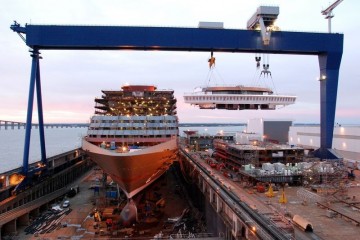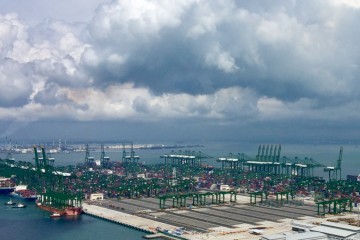Future ports will be bigger, faster, greener and smarter. Put differently, their future is shaped by five phenomena that curiously enough all start with an S: size, space, speed, sustainability and smartness.
Size
Port size is directly related to ship size and carrier size. Bigger ships need bigger ports – and lead to bigger but fewer carriers, which need fewer ports. So the ports system gets more concentrated: the biggest get bigger, the others decline. The critical question for the future is where ship upsizing will stop. My bottom-line: as long as the ones ordering ships will still see an advantage of getting bigger they will do so. If system costs and external costs would be reflected in the price of a ship, it would become more costly. In that case we would have reached the maximum ship size. A pretty safe bet: future ports will need to be much bigger.
Space
Larger ships need more port space, which is limited, especially in cities – and ports are in most cases still located close to cities. This is especially a problem in successful cities: the cities that have growing population. So we will see more ports outside cities, and – pushed to the extreme: more offshore ports, that is: ports that are no longer part of a coastline but are located in the sea, only connected by a road, rail or barge connection to the land. This might be a cheaper option, but does it take into account the often more challenging meteorological conditions in the middle of the sea? Can they ever be as well-connected to hinterland as urban ports?
Speed
Speed is essential for modern ports to remain attractive to carriers. Higher speed means better equipment, more flexibility and more automation. Supply chains are as weak as their weakest link, so it is not enough to be a flexible port that works 24/7, the same will be required of customs, logistics companies and truck drivers. Is everyone ready to give up the current practice of not working at night or in weekends Automation means fewer jobs in the port; in many cases this is not desired. So here is the trade off: does speedier cargo handling create more value than the jobs that were lost via automation? This question is especially relevant in the context of consistently lower speed of ships since a few years.
Sustainable
No port can survive if it is not sustainable. Future ports will need to be green to have “a license to operate”. If not, the resistance of local population will force ports to go elsewhere. Greening ports will evolve from trade offs to win-win situations: in the past it was “either more port or more green”, in the future port and green will be complementary. For example, the circular economy – using waste and remnants from one industrial process as input for another – promises to provide business opportunities for ports and at the same time ways to reduce carbon and energy footprints. How to make this a viable business model for ports? Much will depend on a more entrepreneurial approach of ports and a willingness of regulators to change legislation.
Smart
Finally, being smart is needed to adapt to the other future challenges. For me, smart means: making good use of everything that is scarce in order to create value. So: good value for money, for space, for time. Using all possible technologies, intensively sharing information and data, implementing best practices that worked in ports world wide. A port that is not only landlord, but invests in innovation and wants to be at the frontier of applying new ideas and technologies. A port that is quite far removed from most ports at the moment, that are mostly determined by routines and reactivity rather than anything else.
There we go, the five issues likely to shape future ports are size, space, speed, sustainability and smartness. So, do not be surprised to see in the coming years more offshore ports, more automated ports, more carbon neutral ports and more R&D ports.
Of course, in reality almost everything in the future will be different than we now expect.
3 Comments
Comments are closed.




Dear Olaf,
Doesnt your latest blog to a ceratin extent contradict your earlier posts, to which i whole hearteldy agree regarding economies of scale?
[…] Future of Ports […]
With a move towards a concentration of ports – larger units handling more goods etc. will there then be a growth in the feeder traffic? The goods need to get from the large hubs out to where it is needed. To some degree this will be covered by lorry transportation but new routes might appear?
What do you think: Will the growing container ports give rise to new feeder routes benefitting the smaller ports?